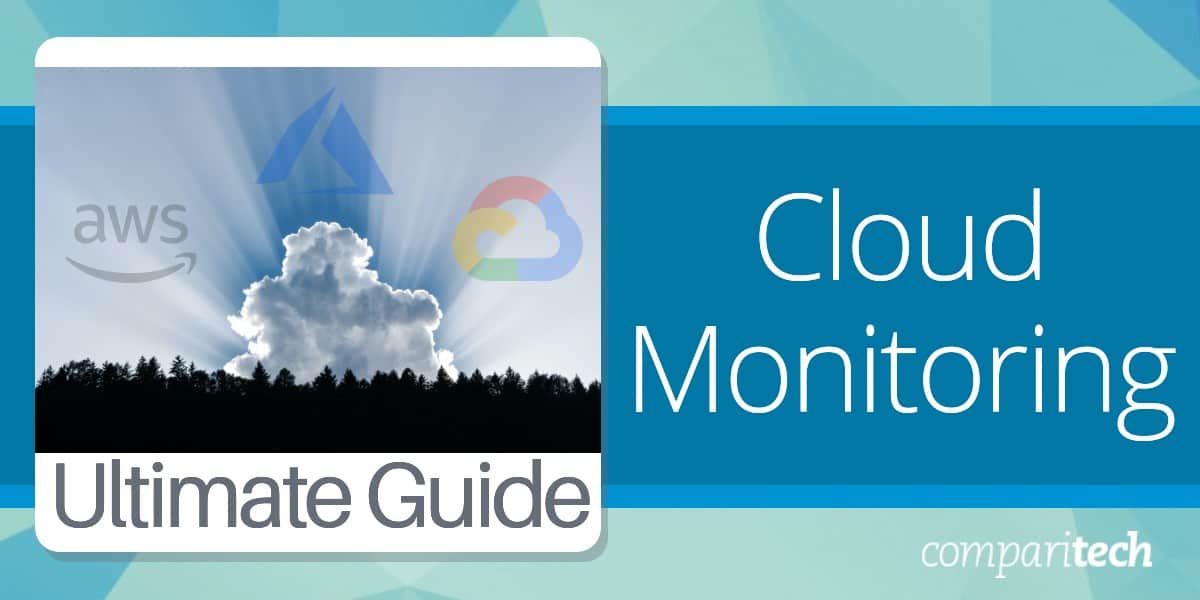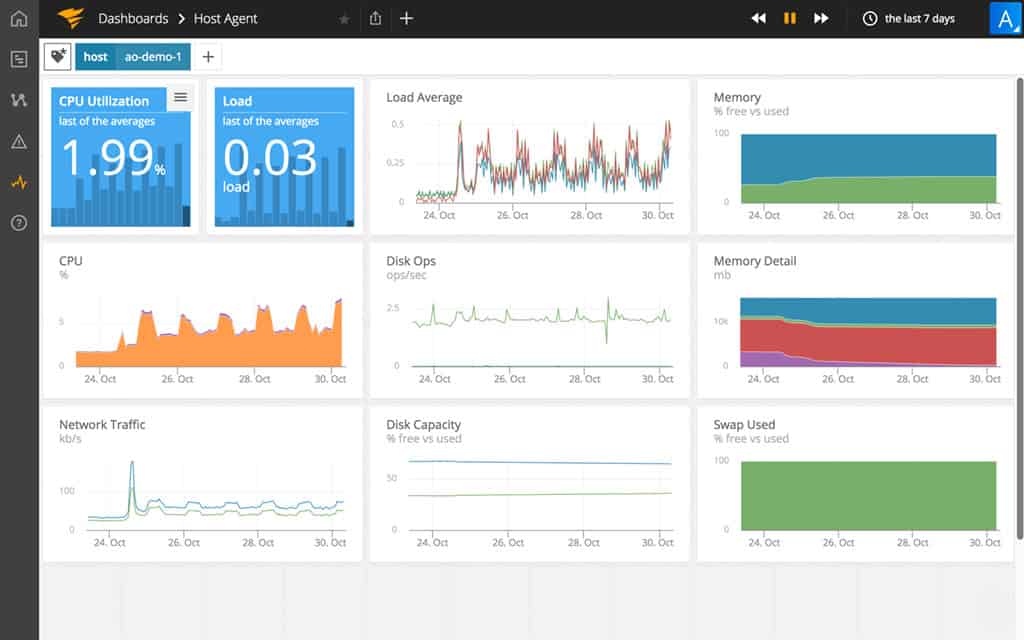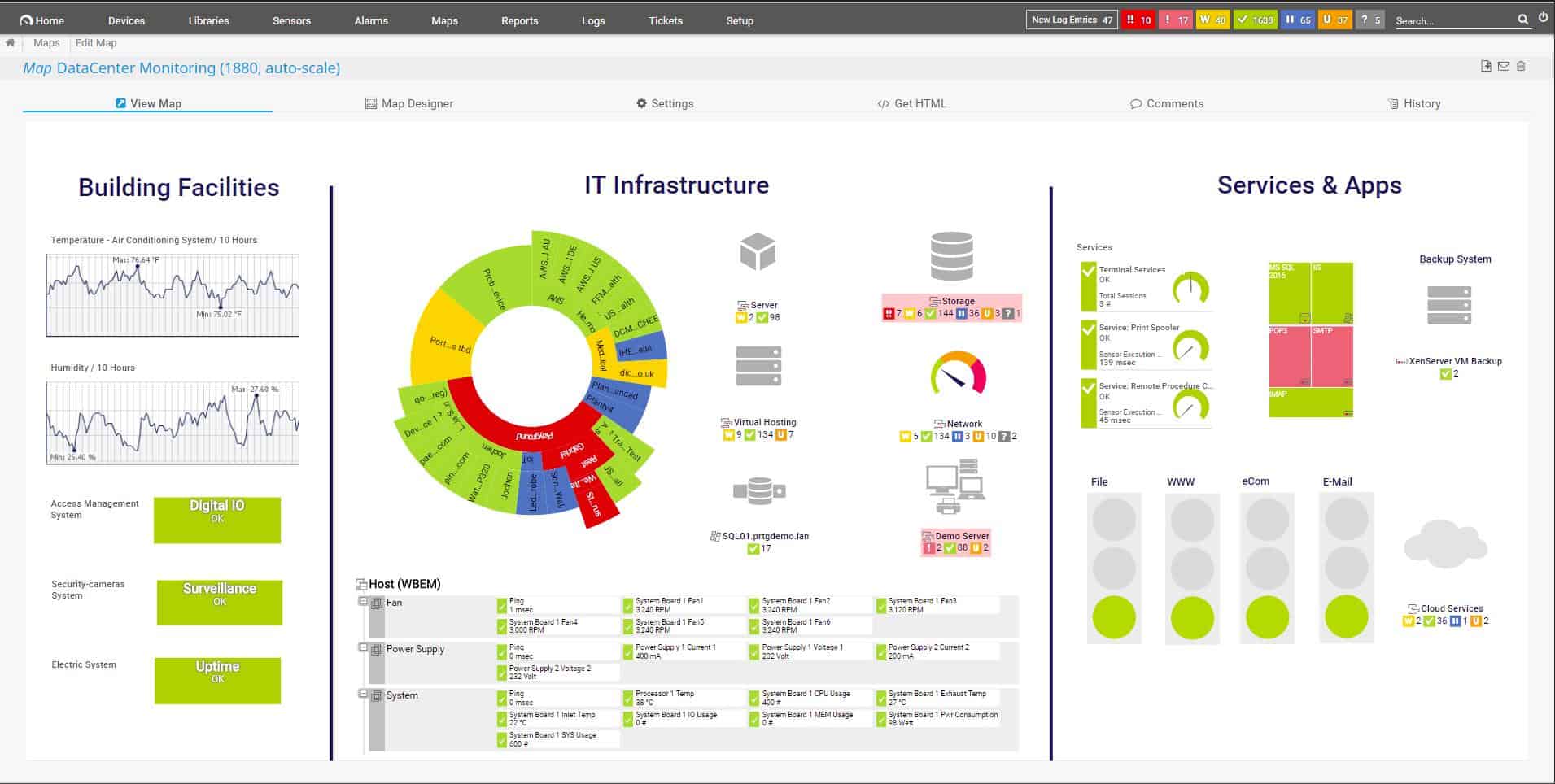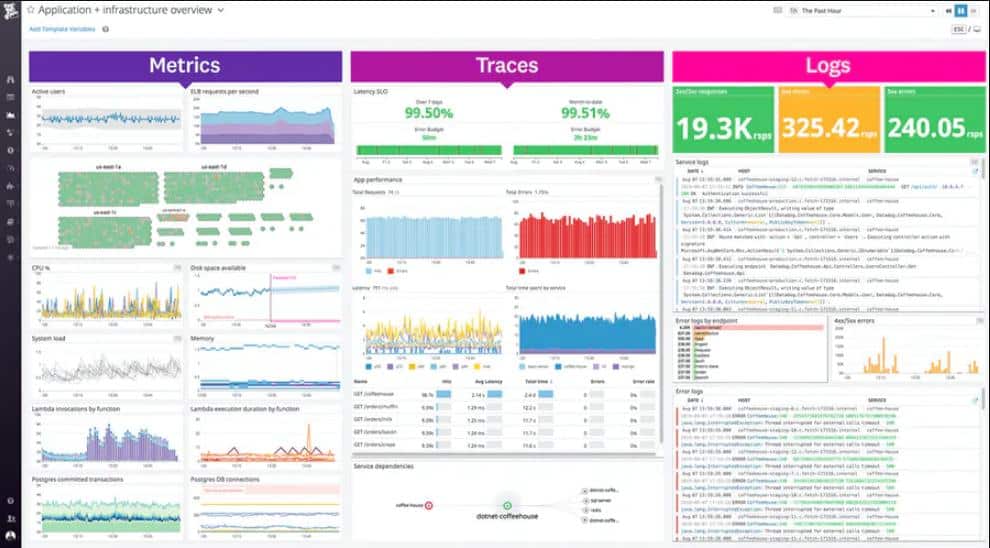A cloud server is a useful extension of a business’s infrastructure. Its off-site location make it a good choice for file backups that can easily be restored should a physical disaster befall your premises. Backup file servers are just one use for cloud systems. Finding a suitable cloud monitoring solution is essential for achieving peak performance in your IT infrastructure.
Cloud infrastructure
An account on a cloud server is a more than just a bit of disk space. A server has an operating system and anyone who can get to that underlying service can access any file held on the server. Cloud systems divide the disk so that it has a separate operating system for each account.
The cloud segmentation of a disk is very similar to a disk partition on a PC. However, the segmentation of the disk is created by a hypervisor. A hypervisor is the main system that implements virtualization, so space on a cloud server is also called a virtual private server, or VPS. Hypervisors are more flexible than partitioning because they are enforced by constantly running software, which enables the boundaries between segments to be altered on demand. This flexibility enables cloud service providers to extend the space allocated to each customer whenever necessary.
So, a cloud system is very flexible and secure. It offers the possibility of renting just a small amount of space that can be expanded later for a larger subscription fee. It is also possible to rent an entire server or a cluster of servers. The choice of configurations is very flexible because most cloud service providers have data centers all over the world. It is possible to rent a small amount of disk space on several servers in different locations, a cluster of servers, a server with a secondary, failover server, and so on.
Cloud-based services
The great flexibility of cloud servers is made a little more complicated by cloud services provided by businesses that rent space on the servers owned by other companies. It is possible to have several reseller layers so the company that you contract for cloud services outsources its data center operations to a second company that rents space on cloud servers owned by a third company.
Legal responsibility
This chain of service provision is becoming common and it is very possible that the business you deal with is not the actual owner of the server where your data gets stored. This complexity becomes a legal issue when dealing with government legislation over the liability for data breaches – GDPR is an example of such legislation.
All of the operators in the chain of responsibility are equally liable for data security, so if you store your company’s data on a cloud server and that server gets invaded by a data thief, you are responsible for that loss even though it was not your server that was hacked. Therefore, you have the legal responsibility to monitor that server and protect the data on it.
Managed cloud servers
You can offload some of the legal responsibility for the security of your cloud servers if you take out a managed server agreement. In this case, the provider agrees to ensure a level of security on the server and install and maintain software on it at your command.
Legally, you are still responsible for the security of the data held on a managed server. However, the managed server is like an insurance policy. If data held on the server gets disclosed, you will be sued and/or fined but your agreement with the managed server provider means that you can recover those financial losses from them. There is still a risk, however, because it is possible that the company you deal with for your managed server does not have sufficient capital to pay compensation for your losses.
Cloud monitoring
As you hold the ultimate responsibility for the security of the data that you hold, no matter where it is stored, you need to monitor your cloud server, just as closely as any server you keep on your premises. The contact you have with the cloud server provider should include a pledge on factors such as server availability and performance levels. However, it is your responsibility to check that those service level agreements are met.
So, using cloud servers doesn’t relieve you of the need to monitor service performance. Whether you install software on a cloud server yourself or subscribe to a Software-as-a-Service plan that includes a hosted application, it is your business that will be damaged if that application doesn’t run at peak performance.
Cloud monitoring options
Many infrastructure monitoring systems are able to supervise networks, servers, and applications in any location. There are network monitors designed for on-premises installation that will also cover networks on a remote site and include connections to cloud services in their scope. Similarly, A server monitor isn’t restricted to monitoring the server that hosts it. A typical server monitor can watch many servers whether they be on the same network, on a remote network, or in the cloud.
It is also very common to find server monitoring tools that are described as suitable for “hybrid environments”. That means businesses that operate servers on promises and in the cloud simultaneously. Such a configuration is not rare because it is the ideal combination used for servers that are backed up on a cloud service.
SaaS cloud monitoring systems
Those businesses that need to monitor a cloud server or service have the option of using a typical network or server monitor that will run on one of their own servers. They also have the option of using a SaaS cloud monitor. SaaS stands for “software as a service”. In this model, the software offered to companies also comes with a hosting server. That server is in the cloud. So, a SaaS cloud monitor is able to monitor a cloud service from its own cloud bae. Like on-premises server monitors, these SaaS monitors are able to supervise hybrid systems that include both on-premises and cloud resources.
AWS CloudWatch
One of the largest cloud server providers is Amazon Web Services. Amazon offers a range of cloud-based services and not just server space. AWS CloudWatch is an integrated system monitor that reports on the performance of many Amazon Web Services. Examples of the services that report to CloudWatch include S3 storage servers, EC2 cloud servers, Elastic Load Balancer, and Application Load Balancer. AWS CloudWatch is available for free and there is also a paid tier.
A number of third-party cloud infrastructure monitoring tools interface with AWS CloudWatch in order to report on AWS features. So, they rely on feeds to CloudWatch rather than gathering statistics on performance directly.
Monitoring agents
Not all cloud infrastructure monitoring systems gather data from AWS CloudWatch. Certainly, those that monitor cloud systems run by other companies need other methods to gather performance data. In most cases, these monitors required an agent program to be installed on the monitored server.
The monitoring agent will run its own queries against the native process managers. Whether the server is based on-premises or in the cloud, an agent will need to be installed. SaaS cloud monitors have the same requirement.
The system of data gatherer and data processor splits the monitoring tasks between two elements. This makes the processing part of a system monitor a lot more flexible and it is the processor-agent model that enables system monitors to supervise hybrid environments.
Azure Monitor
Microsoft Azure is the main cloud platform rival to AWS. The Azure system includes a monitoring service, called Azure Monitor. This is a commercial service that can monitor any server, application, or network anywhere, not just cloud servers running the Azure operating system.
So, Azure Monitoring is not directly comparable to AWS CloudWatch. This monitoring service competes with other independent monitor vendors, such as SolarWinds, Datadog, or Paessler. However, despite its advantage as the monitor built into Azure, it is not as successful as those rival systems.
Are there cloud network monitors?
As a rule, a network monitor can supervise networks on your home site and on remote sites. When reaching out to remote sites, the network that is being monitored in between those two points is actually the internet.
Cloud services are server-based. They connect to businesses and their networks over the internet. So, it is possible to monitor the performance of the network to the cloud but that involves monitoring the internet connections that link cloud servers to the home network.
Network monitors are offered for on-premises installation and on the SaaS model. So, it is possible to monitor the business network and their internet connection to cloud servers from a cloud-based network monitoring tool.
More frequently, when people talk about cloud monitoring systems, they are referring to the task of monitoring servers and applications based on cloud technology.
Cloud monitoring solutions
Putting together a suitable monitoring suite for all of your resources might seem complicated. However, the task is really very straightforward. Generally speaking, nearly all network, server, and application monitors can operate across a network and any software that works over a network will also work over the internet.
When looking for a solution to specifically monitor a cloud system rather than the quality of internet connection to in, you are really looking for a good quality server monitor.
Here is our list of essential cloud monitoring solutions:
- AppOptics Infrastructure (FREE TRIAL) A cloud-based infrastructure monitor that can supervise servers anywhere, including the cloud. Specialized integrations are available for AWS and Azure cloud services monitoring. Start a 30-day free trial.
- Site24x7 Cloud Monitoring (FREE TRIAL) This SaaS service is part of a cloud platform of system monitoring tools that provides hybrid cloud observability. Start a 30-day free trial.
- Paessler PRTG (FREE TRIAL) A network server and application monitoring bundle that is able to include cloud services in the monitoring sphere. It is available for on-premises installation or hosted in the cloud. Get a 30-day free trial.
- Datadog Infrastructure A network and server monitoring system that has special integrations available for cloud infrastructure monitoring.
You can read more about each of these solutions in the following sections.
1. AppOptics Infrastructure (FREE TRIAL)
AppOptics Infrastructure is a cloud-based monitoring system that specializes in supervising server performance. There is a separate package available for application monitoring, called AppOptics APM. Subscribers to the APM service get AppOptics Infrastructure included for free.
Key Features:
- Infrastructure and Application Monitoring: Provides comprehensive monitoring of both server infrastructure and application performance.
- Server Activity Tracking: Monitors server activities to ensure optimal performance.
- Consolidated Metrics: Aggregates performance metrics across all servers for unified monitoring.
- Cloud Platform Monitoring: Includes integrations for AWS and Azure, allowing detailed monitoring of cloud services.
- Annual Payment Discounts: Offers cost savings with annual subscription plans.
Why do we recommend it?
AppOptics Infrastructure is itself hosted on the cloud and delivered as a SaaS subscription. The service looks at the performance of applications, which is a wide remit that covers both user-facing software and the utilities that support those interfaces. The Infrastructure module looks at that second category and it goes right down to the services of cloud platforms and servers.
Although the monitoring system is called “Infrastructure” it doesn’t have many network monitoring features. The system is very focused on server monitoring. It doesn’t matter where that server is because the monitoring system is hosted remotely on the cloud. It also doesn’t matter what operating system each server in your employ has. The AppOptics monitoring system will include all servers in your dashboard and it can consolidate performance metrics for all of them.
The AppOptics system has standard screens in its dashboard, which is accessed through any web browser. Those screens can be added to, however, through a series of add-ons. These are called “integrations” and there are integrations for AWS and Azure monitoring. The monitoring services for both of these two cloud server systems are very similar. The performance metrics for all server types are shown as graphics and any problems that are detected get interpreted in alerts, which are calls to action.
Who is it recommended for?
This package isn’t limited to monitoring cloud infrastructure because it will also look at the systems that you host on your own servers. It is appropriate for businesses that don’t run web applications, such as websites – those assets are monitored by the higher plan of AppOptics and not covered by the Infrastructure module.
Pros:
- Visualizations: Offers intuitive visual representations of live and historical health metrics and resource consumption.
- Scalability: Easily scalable as a cloud service, accommodating growing infrastructure needs.
- Extensive Metrics: Monitors over 180 different metrics, covering major resources comprehensively.
- Platform Flexibility: Supports monitoring of Docker, Azure, and Hyper-V platforms.
Cons:
- Trial Period: A longer trial period would be beneficial for thorough evaluation.
AppOptics has a straightforward pricing structure – there are no editions, just a rate for the infrastructure of APM. There is a tariff that is charged monthly and those who elect to pay annually get a lower rate per month. There is no deposit required and no contract or minimum service period. You can get a 30-day free trial of AppOptics Infrastructure.
2. Site24x7 Cloud Monitoring (FREE TRIAL)
Site24x7 is a SaaS package that is delivered from the cloud. It is able to monitor on-premises systems and cloud resources. The Site24x7 Cloud Monitoring module offers monitoring capabilities for GCP, AWS, and Azure services. The full platform will combine the tracking of all resources wherever they are.
Key Features:
- Integration with Major Cloud Providers: Seamlessly integrates with AWS, GCP, and Azure for comprehensive monitoring.
- Container Monitoring: Provides robust tracking for containerized applications.
- Cloud Security Guidance: Offers detailed security recommendations for cloud configurations.
- Cloud Cost Management: Helps optimize and manage cloud spending effectively.
Why do we recommend it?
The Site24x7 Cloud Monitoring package covers all of the cloud systems that you might need, such as virtual servers, serverless hosting, and containers. The package also provides configuration scanning for security improvements and calculates recommendations on how to save money by switching cloud providers or reducing reserved space.
As well as monitoring cloud platforms, this package can directly access the services that are hosted on those cloud servers. Examples of this include databases, access rights managers, and container systems.
While the Cloud Monitoring service watches over your public and private cloud accounts, companion modules in the plans offered by the Site24x7 platform monitor on-premises systems, including networks, servers, and applications. The tool includes specialized features for monitoring virtualizations and site-hosted containers. It also has utilities for monitoring Web applications, which include code profiling and distributed tracing.
The Site24x7 platform can track the activities of the cloud-hosted systems that you run, which includes the services that your employees use, such as Google Workspace and Microsoft 365. Website and mobile app testing can be launched from more than 120 cloud servers around the globe.
Who is it recommended for?
The Site24x7 package doesn’t just provide cloud monitoring, it also offers on-premises system monitoring and some asset management tools, such as configuration management and log management. The plans for Site24x7 blend all of the tools on the platform and it isn’t possible to just pay for a specific module, such as the Cloud Monitoring service.
Pros:
- Comprehensive Cloud Monitoring: Offers extensive monitoring for cloud platforms and the services running on them.
- Security Configuration Checks: Ensures cloud setups are secure by scanning configurations.
- Hybrid Cloud Support: Facilitates observability across both cloud and on-premises environments.
- Web Application Monitoring: Includes tools for tracking the performance of web applications.
Cons:
- Standalone Option Unavailable: Cannot be purchased as an individual module, only as part of a broader package.
Site24x7 includes its Cloud Monitoring service in all of its plans. The options are all sized for small businesses and have very affordable subscription rates, starting at $9 per month. Those base plans don’t provide much capacity although they have a broad list of services. So, most companies will have to pay for capacity expansion packs on top of the base subscription rate.
The Site24x7 platform is only available as a hosted cloud SaaS package. The list of editions includes the MSP plan, which is designed for use by managed service providers. You can try out any of the Site24x7 plans with a 30-day free trial.
3. Paessler PRTG (FREE TRIAL)
Paessler PRTG is an all-in-one monitoring bundle that offers supervision of networks, servers, and applications. The exact scope of this system is up to the user because it is made up of a collection of “sensors,” each of which is a specialist monitor. The customer gets charged according to the number of sensors that get activated.
Key Features:
- SaaS or On-Premises: Can be used as a cloud service or installed on a Windows Server.
- Free Sensor Limit: Free to use for up to 100 sensors.
- Comprehensive Cloud Monitoring: Provides extensive monitoring for various cloud platforms and services.
Why do we recommend it?
Paessler PRTG is a package of many tools and you choose which of them to activate. This bundle includes tools to check on the performance of cloud platforms and the services that run on them. It also looks at the performance of web delivery services, which is how many cloud systems get to your users.
Among the list of sensors are specialist monitors for cloud resources. There are sensors available for AWS, which include Elastic Block Store (EBS), Amazon Elastic Compute Cloud (EC2) Amazon ElastiCache, Amazon Relational Database Service (RDS) Amazon simple notification Service (SNS), and Amazon Simple Queue Service (SQS). PRTG also includes sensors for Azure, Dropbox, Google Drive, Google analytics, and a list of mail servers.
Connection sensors in the package can test the speed and availability of connections to your cloud servers and there is even a sensor that can test availability from several locations around the world.
Who is it recommended for?
PRTG is available as an on premises package for Windows Server or as a SaaS platform. Buyers pay for an allowance of sensors and then decide which of the sensors in the PRTG bundle to turn on. If you only activate 100 sensors, you don’t have to pay anything. PRTG has a collection of sensors for monitoring AWS but is not very strong at monitoring other cloud platforms.
Pros:
- Broad Cloud Support: Excellent for monitoring diverse cloud environments and multiple cloud products.
- User-Friendly Customization: The drag-and-drop editor simplifies the creation of custom views and reports.
- Flexible Integration: Easily integrates with helpdesk systems and third-party messaging platforms.
- Customizable Sensors: Highly adaptable sensors for creating personalized monitoring solutions.
- Robust Free Version: Freeware version supports up to 100 sensors, making it accessible.
Cons:
- Technical User Focus: Best suited for network professionals, which might make it less user-friendly for non-technical users.
Paessler PRTG is available as software for installation on Windows Server, and it can also be accessed in a SaaS format. The on-premises version can be downloaded for a 30-day free trial with unlimited sensors.
4. Datadog IT Infrastructure Monitoring
Datadog is a cloud-based infrastructure monitoring system that can monitor servers anywhere. Datadog uses both an agent and native process monitors to supervise servers. It is able to include many servers into a unified monitoring environment and it can easily manage hybrid systems that combine both on-premises and cloud servers.
Key Features:
- AWS and Azure Integrations: Seamlessly integrates with major cloud providers, expanding its monitoring capabilities.
- Customizable Dashboards: Fully customizable to suit the specific needs of your infrastructure monitoring.
- Data Retention: Offers long-term data retention, ensuring access to historical performance data.
- Free Edition: Provides a basic free tier, allowing smaller teams to monitor core infrastructure without additional costs.
Why do we recommend it?
The Datadog Infrastructure Monitoring package tracks the performance of all of those services that operate between user interfaces and server resources. This includes systems such as cloud platforms (which are hosted on physical servers located somewhere else), databases, and logical servers, such as Web servers, and email servers.
Datadog can be expanded by integrations. These add-ons create extra screens in the dashboard and extend the monitoring capabilities according to the specialization of the integration. There are integrations for AWS and Azure monitoring available. Both are free to add to a Datadog Infrastructure package.
Datadog’s dashboard features many graphical representations of performance data. The information is also available in tabulated test form in detail screen. The main dashboard is customizable but the out-of-the-box version presents a summary of statistics on all of the servers included in the monitoring environment. Clicking on each metric gets it displayed [per server. It is also possible to get a single server view of all metrics.
Applications running on cloud servers can be examined by a separate monitoring service, called Datadog APM. Taking out subscriptions to both Infrastructure and APM creates an integrated view of the full stack from software down to transmission medium.
Who is it recommended for?
Datadog is a very large platform of monitoring systems and the Infrastructure module is the core package of the service. For example, if you want to use the Network Device Monitoring package of Datadog, you need to have the Infrastructure Monitoring service running first. This unit can be expanders by activating integrations that add monitoring for the specific services that you use.
Pros:
- Cloud Environment Integration: Out-of-the-box support for AWS and Azure simplifies cloud infrastructure monitoring.
- Intuitive Interface: The dashboard is user-friendly and easily customizable, making it accessible for all skill levels.
- Comprehensive Monitoring: Monitors both internal and external systems, offering a complete view of network health.
- Scalable Solution: Flexible pricing options ensure the tool can grow with your business, from startups to large enterprises.
Cons:
- Short Trial Period: The trial period is relatively brief, which might limit thorough testing for complex environments.
Datadog Infrastructure is a subscription service. It can be paid monthly or annually – the annual rate works out cheaper per month. Datadog calls the month-to-month subscription “on demand”.
This monitoring system is offered in three editions: Free, Pro, and Enterprise. The big draw of the Free edition is that, as its name suggests, it costs nothing to use. However, it has limits on the number of hosts that it will monitor (5) and only has a data retention period of one day. However, it is still a very useful service for small businesses that have no budget for monitoring software. You can get a 14-day free trial of either the Pro or Enterprise edition.








